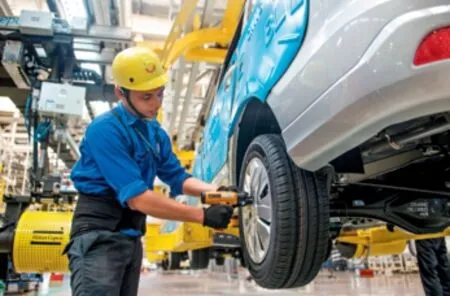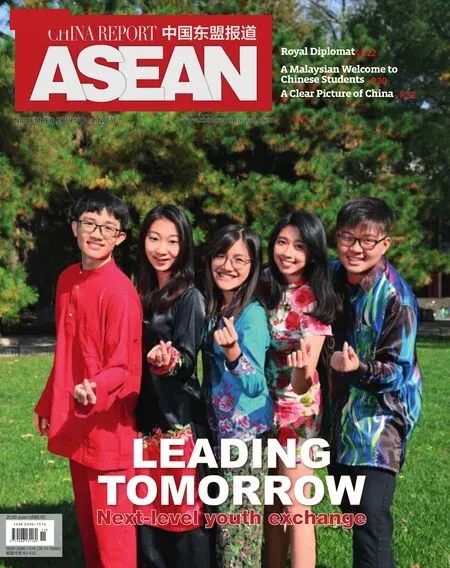THE DEMONSTRATION EFFECT OF UPGRADING
2019-12-04ByWangQin
| By Wang Qin |
10 years of ASEAN-China Free Trade Area

China (Guangxi)Pilot Free Trade Zone is offcially inaugurated with the unveiling of its Chongzuo Area at a ceremony in Pingxiang Integrated Free Trade Zone,Guangxi, on August 30, 2019.
Nearly 10 years have passed since the official establishment of China-ASEAN Free Trade Area (CAFTA) on January 1, 2010.Across its 10 years of operation, CAFTA has played an increasingly important role in supporting trade and investment between China and ASEAN and bolstering the Belt and Road Initiative as it provides valuable experience for China to build more free trade areas (FTAs).
China's First FTA with Foreign Partners
In the 21st Century,China has accelerated implementation of its FTA strategy by gradually building a high-standard global network of FTAs.China built its FTAs from scratch, and is now working on 20 FTAs which involve 32 countries and regions.It has signed 14 free trade agreements with 20 countries and regions.CAFTA was the first FTA built by foreign partners alongside China.
China first proposed the idea of a China-ASEAN Free Trade Area in 2001.In November 2002, China and ASEAN signed the Framework Agreement for Comprehensive Economic Cooperation, establishing the basic structure of CAFTA.In January 2004, the “early harvest program” of the agreement was successfully implemented.China signed separate agreements with ASEAN on trade in goods,services and investment in 2004, 2007 and 2009 respectively.China and the six original members of ASEAN(Brunei, Indonesia, Malaysia,the Philippines, Singapore and Thailand) implemented zero tariffs on 90 percent of products starting January 1, 2010.CLMV countries(Cambodia, Laos, Myanmar,Vietnam) followed suit in 2015, marking completion of China’s first FTA with foreign partners.In October 2013,China proposed launching negotiations to upgrade the CAFTA.In August 2014,the two sides announced commencement of CAFTA upgrade negotiations.In November 2015, the two sides signed the CAFTA Upgrade Protocol, which concluded negotiations to upgrade China’s first FTA with foreign partners.
Alongside development of CAFTA , the scale of China-ASEAN bilateral trade has expanded rapidly, and economic effects of regional integration gradually emerged.China’s total trade in goods with ASEAN reached US$100 billion in 2004, US$200 billion in 2007, US$300 billion in 2011,US$400 billion in 2012, US$500 billion in 2017, and US$587.87 billion in 2018.By the end of 2018, China-ASEAN twoway investment in aggregate grew to US$205.71 billion with a 22-fold increase in mutual investment stock in 15 years.China has been ASEAN’s largest trading partner for 10 consecutive years, and ASEAN has become China’s second largest trading partner.

Since the CAFTA was established, the scale of mutual investment between China and ASEAN has continuously expanded.As of May 2018,two-way investment between China and ASEAN totaled more than US$200 billion, with US$86.5 billion of Chinese direct investment in ASEAN countries and US$113.9 billion of ASEAN investment in China.So far, China has set up more than 4,700 direct investment enterprises in ASEAN countries, employing 353,000 local employees.Chinese companies have built 23 investment projects as overseas economic and trade cooperation zones in eight ASEAN countries (excluding Singapore and the Philippines).
ASEAN has become an important engineering contract and labor cooperation market for China.All 10 ASEAN member states have become approved destinations for Chinese tourists.By the end of May 2018,Chinese companies had signed engineering contracts worth US$363.96 billion with ASEAN countries, with a turnover of US$239.92 billion.In 2018, more than 50 million tourist trips were made between China and ASEAN, including 30 million Chinese tourists visiting ASEAN countries, an increase of 30 percent over 2017, and more than 22 million ASEAN tourists visiting China, an increase of 105 percent year on year.
Largest FTA along the Belt and Road
Thanks to the construction of the ASEAN Community and the Belt and Road, an upgraded version of CAFTA will emerge and herald a new stage for China-ASEAN economic and trade relations.CAFTA is now the largest FTA along the Belt and Road and plays an important role in promoting connectivity,industrial capacity cooperation and people-to-people exchange along the routes.
The rapid rise of Chinese and ASEAN economies has made the region served by the CAFTA the world’s fastestgrowing market with greatest potential.China and ASEAN are respectively the most populous and third most populous regions in the world,the second and sixth largest economies, the first and fourth largest import and export trade regions, and one of the important destinations of foreign direct investment (FDI)in the world.In 2017, China’s trade with countries along the Belt and Road amounted to US$1,440.32 billion, including US$514.82 billion of trade within CAFTA, accounting for 35.74 percent of the total.Six of the top 10 Chinese trading partners along the Belt and Road are ASEAN countries:Vietnam, Malaysia, Thailand,Singapore, Indonesia and the Philippines.By the end of 2017,China’s FDI stock in countries along the Belt and Road was US$154.40 billion, of which US$89.01 billion was in ASEAN countries, accounting for 57.65 percent of the total.Six of the top 10 countries along the Belt and Road with the largest Chinese FDI stocks are ASEAN countries (Singapore,Indonesia, Laos, Myanmar,Cambodia and Thailand).

The overall completion of CAFTA has abolished tariff barriers, weakened nontariff measures and reduced investment restrictions,contributing to the expansion and integration of regional markets and accelerating infrastructure connectivity in the region.ASEAN is an important hub of infrastructure connectivity between China and countries along the Belt and Road.In recent years,Chinese companies have actively participated in construction of infrastructure projects in ASEAN countries such as highways, railways,power stations and communication networks.Standout examples include the Bangkok-Korat Railway in Thailand, the Jakarta-Bandung Railway in Indonesia and the Laos-China Railway.The Surabaya-Madura Bridge,Indonesia’s largest cross-sea bridge, was built by China Communications Construction Company Ltd (CCCC).The first light rail in the city of Palembang, Indonesia, was constructed by China Harbour Engineering Company Ltd(CHEC) and is now in service.The first light rail in Hanoi,Vietnam, constructed by China Railway Group Limited(REG), now serves passengers.Sinohydro Corporation Ltd has undertaken the construction of Nam Ngum 3 Hydropower Station, the largest of its kind in Laos and the first to be built by a Chinese company.
In 2016, China and ASEAN issued Joint Statement on Production Capacity Cooperation and Joint Statement on Production Capacity Cooperation among Lancang-Mekong Countries, which identified capacity cooperation as a priority of regional cooperation between China and ASEAN.In recent years, ASEAN has become an important region for Chinese enterprises to“go global,” and the most attractive destination for Chinese investment has been countries along the Belt and Road.In 2017, China’s direct investment flow in the 10 ASEAN member states reached US$14.12 billion, with a stock of US$89.01 billion.Chinese investment in traditional industries such as agriculture,fishery, manufacturing, mining and real estate in ASEAN countries continues to expand.For emerging industries,China-ASEAN production capacity cooperation focuses on sectors such as nextgeneration information technology, advanced rail transit equipment, marine engineering equipment,energy-saving and new energy vehicles, new materials,biomedicine and highperformance medical devices.

A worker on the assembly line of the SAIC-GMWuling Automobile (SGMW) plant in Cikarang,Indonesia, on March 14, 2019.

An aerial view of the Nanning Area of China (Guangxi) Pilot Free Trade Zone in Wuxiang New District of Nanning, capital of Guangxi Zhuang Autonomous Region in south China.
Within the framework of the CAFTA agreement on trade in services, China and ASEAN have been committed to further opening up educational services to each other, which has created conditions for the countries to eliminate educational barriers and share resources.In 2015, the governments of China and Indonesia established a people-to-people exchange mechanism that was unprecedented among developing countries.In 2010,the Chinese government introduced the “Double 100,000 Plan” which aims to increase the numbers of Chinese students in ASEAN countries and ASEAN students in China to 100,000 respectively by 2020.In 2016,China proposed the “China-ASEAN Maritime Silk Road Scholarship.” China has signed educational exchange agreements with eight ASEAN countries and agreements on mutual recognition of academic records and degrees with Thailand and Malaysia.Education cooperation and exchange have already been carried out in elementary education, secondary education, vocational education and higher education.In 2017, 220,000 students were studying in each other’s universities.China-ASEAN educational and cultural cooperation and exchange have played a demonstrative role for cultural and people-to-people exchange along the Belt and Road.trade in goods and services and reducing restrictions on investment.According to the contrasting development levels of various ASEAN member states, CAFTA has implemented a phased and differentiated tariff reduction and elimination timetables for China, the six original members of ASEAN and CLMV countries.

Third, CAFTA has created an ideal business environment for regional enterprises to integrate into the global value chain.In recent years, direct investment by transnational corporations in China and ASEAN has expanded rapidly, making the region an important node of the global value chain.At the same time, trade of intermediate products between investment enterprises of multinational corporations in China and ASEAN countries has led to sustained growth of trade between China and ASEAN.
Finally, the upgraded version of CAFTA has had a demonstration effect.In November 2015, China and ASEAN signed the CAFTA Upgrade Protocol, concluding the first negotiation on the upgrading of China’s FTA with foreign partners.By readjusting rules of origin, accelerating trade facilitation, expanding areas for trade in services and deepening economic and technical cooperation, the protocol laid the groundwork for a better regional free trade network.The successful upgrading of CAFTA will serve as an example for China to upgrade more FTAs in the future.
Experience and Demonstrative Effects
Since completion of CAFTA in 2010, China has reached a stage of building a high-end global FTA network.As China’s first FTA with foreign partners,CAFTA provides experience for reference that will be key as China forges more FTAs.
First, CAFTA established a mutually-beneficial and winwin institutional arrangement.With varying development gaps differentiating China and the 10 ASEAN member states,implementation of CAFTA took economic development and market affordability into consideration to promote the formation and development of a regional unified market by gradually expanding market access and eliminating trade and investment barriers.Meanwhile, to ensure the interests of some less developed countries are met, a phased and differentiated tariff reduction model and timetable have been tailored to improve sharing of the benefits of regional economic integration.
Second, CAFTA has innovated the tariff reduction model.It creatively designed the “early harvest program”to help member economies enjoy the benefits of the FTA more quickly.By using a step-by-step approach characterized by solving easy problems first, CAFTA launched the early harvest program of tariff reduction on agricultural products in 2002 before gradually opening
